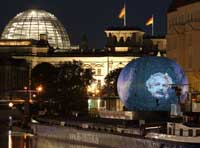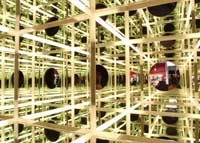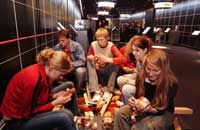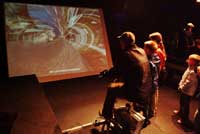The exhibition ship MS Einstein: a floating source of scientific knowledge Teach article
Imagine a barge carrying not coal or other heavy cargo, but something much more precious – inspiration! Beate Langholf from Wissenschaft im Dialog, Germany, describes a science exhibition that travels the rivers of Germany with a different theme each year.

“The most important thing is to never stop questioning.” That was the advice given to a young student by Albert Einstein in 1955. It was therefore an appropriate motto to adopt for the exhibition aboard the MS Einstein – Wissenschaft im Dialog’s exhibition ship. Beginning on 9 May 2005, the ship travelled through Germany, stopping at 36 different cities along the way. It finally ended its tour in Basel, Switzerland, on 19 September.
The 105-metre barge had already been underway with its unusual cargo for a number of years. It was not, you see, carrying a load of containers or coal but rather a much more sensitive freight: a science exhibition designed for a wide audience, including children and young adults. The exhibition theme is chosen each year to coincide with the current science year proclaimed by the German Ministry of Education. In 2002, the University of Bremen created the Geoship. Subsequently, the MS Chemie (chemistry, 2003), the MS Technik (technology, 2004) and the MS Einstein (2005) were floated by Wissenschaft im Dialogw1.

The goal of this initiative by German science organisations is to draw attention to current scientific research as well as to encourage a lively dialogue between the world of science and the general public.
Two weeks before the planned start of the exhibition, captain Albrecht Scheubner brought the MS Jenny (the ship’s name for much of the year) to the appointed harbour in Bremen. The exhibition, which had been planned over the preceding months, was then rapidly set up on board. Crewed by young scientists, the exhibition was free to visit.
“How fast does time pass?”, “Is there really nothing faster than the speed of light?”, “Why will I age faster on earth than I will in a rocket travelling through space?” Answers to these questions and many more were to be found on the MS Einstein.
Nine themed zones in the bowels of the exhibition ship explained the Nobel prize-winner’s theories in such a way that even non-physicists could understand them. The zones covered the photoelectric effect, the general and special theories of relativity, mass-energy equivalence, stimulated emission as well as cosmology.

unsolvable puzzle
Along the side of the ship, a time-line reflected aspects of Einstein’s personal life. Finally, Einstein’s failed search for a unified theory of everything was demonstrated symbolically through the use of a giant three-dimensional and (almost!) unsolvable wooden puzzle.
These are only a few examples of the numerous interactive stations at the exhibition. The purpose of the hands-on exhibits was, of course, to handle and examine them. Curiosity drove a school group to press around the table in the ‘Einstein and me’ room. And that was exactly the point of this room – to awaken curiosity and stimulate the appetite of both children and adults for exploration and investigation. The students cooperated to try to find solutions to the tricky puzzles on display; for example, try to join nine points (arranged in rows of 3 x 3) with four straight lines. Everyone wanted to try their own luck and numerous attempts failed. With a helpful hint from one of the exhibition’s organisers, however, the students finally succeeded and the resulting euphoria accompanied them to the next table and the next challenge.
The exhibition on the MS Einstein was designed for students in grade 9 (age 15) and above. Younger children were nonetheless able to stay busy and have fun with the numerous playful components of the exhibition.

Many teachers had never seen their students so engaged. For the teachers, the visit to the exhibition ship complemented their natural-sciences lessons. The exhibition demonstrated the uses of scientific theories in everyday life, as well as showing research being done in colleges and research centres. The students were thereby able to take a close look at the practical and daily relevance of scientific work. Classroom knowledge and schoolwork could be seen in relation to a bigger picture.
Some students, of course, refuse to be enthused by anything. Nonetheless, there is almost never any trouble on the exhibition ship: the continuous refinement of the interactive concepts has gradually succeeded in ridding the exhibition of vandalism. The mixture of interactivity, suspense and concentration has been key.
Among those planning the exhibition ship were representatives from the participating science organisations such as the Fraunhofer Gesellschaftw3, Helmholtz Gemeinschaftw4, Leibniz Gesellschaftw5 and the Max Planck Gesellschaftw6. Together with the exhibition agency, they ensured that the proposed exhibits were suitable for exhibiting and developed some hands-on exhibits specially. The overall goal of the exhibition was to make up-to-date research findings readily accessible to a broad audience.
The fact that the exhibition was on a barge meant that many people attended who would not normally visit a scientific exhibition. The unusual location and the fact that it was free also drew many chance visitors. People who only wanted to take a look often ended up spending many hours in the ‘floating science centre’ and showed up again the next day with friends or family in tow. The exhibition organisers heard almost nothing but positive feedback.
Young scientists in teams of four ‘pilots’ were responsible for answering visitors’ questions and supervising the exhibition. Many have been so thrilled by the work that they come back year after year. These students from the most diverse fields of study were able to gain a familiarity with communication and conveying scientific subject matter to others. And they were also willing to accept that, at the end of the day, they might be handed a vacuum cleaner or a screwdriver to ensure that everything was ship-shape, ready for the next day.
After about four months and 100 000 visitors, the exhibition was dismantled: the attendants and organisers went home, the exhibits were returned to their institutions, and the MS Jenny went back to carrying her normal freight. But the planning continues: the MS Wissenschaft – Sport and Computer Science will use sporting themes in 2006 to answer questions like “how does computer science function?”, “what can it do?” and “where can it be found at work?”w2 So, once again, the slogan will be: science ahoy!
Help is at hand
If you are interested in setting up a similar exhibition in your own country and would like advice, the Wissenschaft im Dialog team would be happy to help. Contact Beate Langholf (beate.langholf@w-i-d.de).
Web References
- w1 – Wissenschaft im Dialog is committed to ensuring a constant dialogue between scientists and as many people and social groups as possible
- w2 – Details of the MS Wissenschaft’s trip in 2006, including a timetable (German)
- w3 – The Fraunhofer Gesellschaft is the largest organisation for applied research in Europe
- w4 – The Helmholtz Gemeinschaft is Germany’s largest research institution
- w5 – The Leibniz Gesellschaft is a scientific organisation comprised of 84 non-university research institutes and service facilities
- w6 – The institutes of the Max Planck Gesellschaft perform basic research in the interest of the general public in the natural sciences, life sciences, social sciences, and the humanities
Review
Welcome aboard a scientific cruise on German rivers!
An exhibition ship has been travelling through many cities on German rivers each summer with a scientific exhibition. The idea is that what is researched and discovered in laboratories and universities is of interest to all of us because science and research significantly influence the living conditions and culture of our society.
The boat (which was originally called MS Jenny but which changes its name each year according to the theme of the exhibition) is open to school classes and all visitors from May to September. This year’s name is MS Wissenschaft – Sport and Computer Science. Read this article and go on board!
Sølve Marie Tegnér Stenmark, Norway





